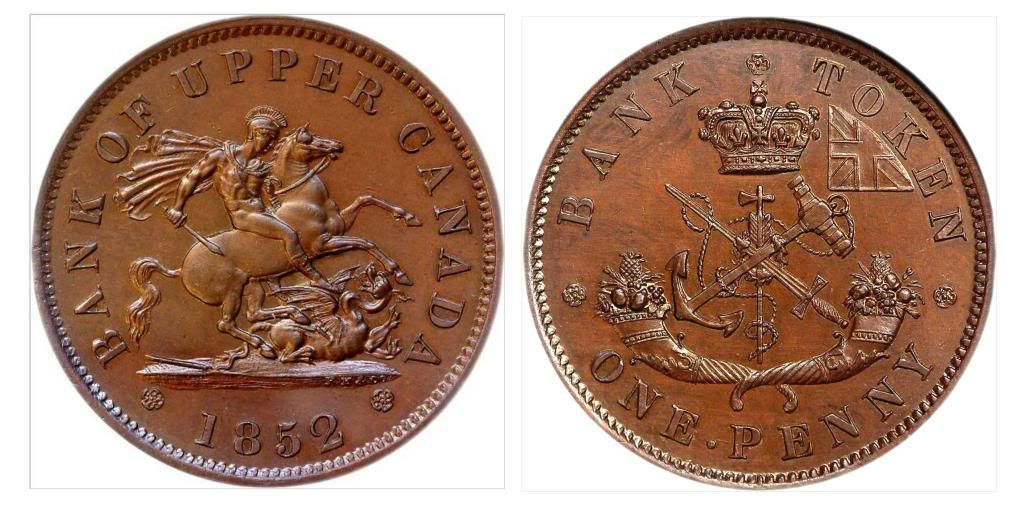1852 Upper Canada Penny Token
"Concerning the 1852 ONE PENNY token:
Another beautiful token. In my opinion, another MS-63.
To assist in the attribution of the variety, I will need to know the die-axis.
Again, in the future, kindly generate a new thread for each item.
doug "
Medal alignment

Bob
Another beautiful token. In my opinion, another MS-63.
To assist in the attribution of the variety, I will need to know the die-axis.
Again, in the future, kindly generate a new thread for each item.
doug "
Medal alignment

Bob
British Historical Medals https://photos.google.com/share/AF1QipOBxKspf6DVpvjgXptTKSr_tZcyeWIRJRBX7ZklmSP59IKhtiAkgF2NB0-Vxyhz1w?key=OGdSRXJtZWdsb2VodmNEdWJ4VF9jY01YdmJtRTlB
Conder Token Gallery https://photos.google.com/share/AF1QipMCiunai6NjOxoo3zREkCsAnNm4vONzieO3u7tHyhm8peZmRD_A0MXmnWT2dzJ-nw?key=Rlo2YklUSWtEY1NWc3BfVm90ZEUwU25jLUZueG9n
Conder Token Gallery https://photos.google.com/share/AF1QipMCiunai6NjOxoo3zREkCsAnNm4vONzieO3u7tHyhm8peZmRD_A0MXmnWT2dzJ-nw?key=Rlo2YklUSWtEY1NWc3BfVm90ZEUwU25jLUZueG9n
0
Comments
DPOTD-3
'Emancipate yourselves from mental slavery'
CU #3245 B.N.A. #428
Don
-~-~-~-~-~-~-~-~-~-~-~-~-~-~-~-~-~-~-~-~-~-~-~-~-~-~-~-~-~-~-~-~-~-~-~-~-~-~-~-~-~-~-~-~-~-~-~-~-~-~-~-~-
My sets: [280+ horse coins] :: [France Sowers] :: [Colorful world copper] :: [Beautiful world coins]
-~-~-~-~-~-~-~-~-~-~-~-~-~-~-~-~-~-~-~-~-~-~-~-~-~-~-~-~-~-~-~-~-~-~-~-~-~-~-~-~-~-~-~-~-~-~-~-~-~-~-~-~-
Do they exist in coinage alignment also?
According to Charlton, the Royal Mint produced the penny and halfpenny tokens for 1850 and some of the penny and halfpenny tokens for 1852,
but contracted with the Heaton Mint to complete the 1852 order. The Heaton Mint also produced the tokens for 1854 and 1857. The Royal Mint tokens
were produced in medal orientation while the Heaton Mint tokens were produced in coinage orientation.
Conder Token Gallery https://photos.google.com/share/AF1QipMCiunai6NjOxoo3zREkCsAnNm4vONzieO3u7tHyhm8peZmRD_A0MXmnWT2dzJ-nw?key=Rlo2YklUSWtEY1NWc3BfVm90ZEUwU25jLUZueG9n
Again, a beautiful token.
This is Doctor Eugene Courteau variety 245, having an R factor of 6 (on a scale of 1-10).
Dr. Courteau mentions having a 'light die-crack to the K in BANK' (obverse), and a 'light
die-crack to the crown, between K and rosette.'
Concerning these die-cracks, in my work, I provide the following data.
This Die-Crack is from the right-section of the Denticle above the Upright of the K in BANK,
extending through the left-side of the Serif of the same Upright, on-line with the left-side
of the same Upright, and running parallel to the left-side of the same Upright, and exiting
to the mid-section of the lower edge of the Blade of the Dagger.
This relatively straight Die-Crack is from betwixt the 2nd and 3rd Denticles to the immediate
left of the upper Rosette, extending to the top of the inner upper left-side Crown Jewel,
slightly to the left of the apex.
doug
Courteau varieties appear to be different than Morgan dollar VAM#'s or Conder token D&H#'s (which represent distinct die combinations).
Could you clarify what a Courteau variety represents?
Thanks!
Bob
Conder Token Gallery https://photos.google.com/share/AF1QipMCiunai6NjOxoo3zREkCsAnNm4vONzieO3u7tHyhm8peZmRD_A0MXmnWT2dzJ-nw?key=Rlo2YklUSWtEY1NWc3BfVm90ZEUwU25jLUZueG9n
Doctor Eugene Courteau varieties are to Canadian Colonial Tokens, what VAM varieties are to Morgan Dollars and
what Doctor Haxby's varieties are to 1859 Canadian Large Cents.
Each represents a different major variety or die marriage.
Charlton merely identifies this series (1854 ONE PENNY) into 4 major groupings according to whether the numeral
2 is Small, Narrow, Large, or Wide.
In addition, Doctor Courteau references 4 different placements of the numeral 2. The left side of the base of the 2
is on-line with:
The centre of a Denticle on varieties 234, 236, 237, 239, 242, 243, 254, and 255.
The left-side of a Denticle on varieties 235, 240, 244, 252, and 253.
Betwixt two Denticles on varieties 238, 256, and 257.
The right-side of a Denticle on varieties 241, 245, 246, 247, 248, 249, 250, and 251.
Concern is also given to the Grass Blades of the right Cornucopia (above and to the left of the right rosette).
These are found shewing no upper blade, two light blades...the lower much longer, two blades, the upper is
hevy, but its centre is not filled in, etc.
Concern is also given to whether the numeral 2 is re-cut.
The 2 is re-cut on varieties 239, 247, 248, 252, and 253.
Doctor Courteau also mentions whether the Anchor Ring is perfect or broken.
There are many more diagnostics to examine, and it is a tedious process of elimination.
doug
What throws me is the inclusion of die cracks as a diagnostic for variety rather than die state.
Presumably, a die will begin service uncracked and cracks will only emerge (sometimes catastrophically) as the die is used.
Some collectors like to collect on the basis of die states where the extent of cracks, cuds and other degeneration is tracked.
I tend to prize examples of tokens that usually come with evidence of die cracks before the cracks developed.
Am I missing something or is this just a Courteau thing?
Bob
Conder Token Gallery https://photos.google.com/share/AF1QipMCiunai6NjOxoo3zREkCsAnNm4vONzieO3u7tHyhm8peZmRD_A0MXmnWT2dzJ-nw?key=Rlo2YklUSWtEY1NWc3BfVm90ZEUwU25jLUZueG9n
Dr. Courteau does not utilize die-cracks as a sure-fire diagnostic.
Dr. Courteau often mentions 'Perf. (perfect) and brok. (broken) die,' or
'generally with a die-crack thro. (through)..., 'Perf. and brok. dies; especially...' etal.
The varieties are identifiable by variety without mentioning die-cracks. Dr. Courteau
merely mentioned some conspicuous die-cracks as a convenient reassurance to the
student of having properly attributed the token.
This is similar to the 1859 DP #1 ONE PENNY. This coin can be properly attributed by
examining the numeral 9. However, the 3 diagnostic obverse die-cracks further confirms
the attribution.
Dr. Courteau was not concerned of the die-stages and the die-crack progressions, but
merely the variety. Whereas, in my work, I greatly expanded upon this subject and
preformed an exhaustive study of the die-crack progressions.
Also, an aside is should clarify. Dr. Courteau's work is rather abbreviated and curt.
For ensample, concerning the placement of the numeral 2 from the previous post:
Normally Dr. Courteau only mentioned the placement of the 2 in order to differentiate
one possibility from another close contender. When doing so, Dr. Courteau did not
bother to mention the specific placement of the 2 of the other. In my work, I identify
all characteristics of all varieties.
doug
doug